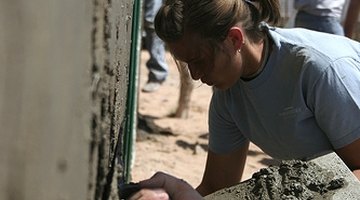DIY- Stucco Mobile Home Skirting
Skirting or underpinning adds a finished look to a mobile home. It helps keep cold air out, providing insulation, and keeps animals out from under the home. A stucco finish is attractive and can be installed easily.

Stucco is naturally a gray color; you can also mix some colors into the stucco or paint it after it has dried for a different look. You can choose from several different textures for the stucco finish to complement your home.
Preparing the Surface
When applying stucco, you must have a solid skirting in place. If your mobile home lacks an underpinning or skirting, you'll need one installed as your first step. The underpinning can be constructed of concrete, concrete blocks, brick or wood. Since stucco is primarily a finish, it should not be relied upon for strength. Therefore, applying stucco over a soft underpinning such as foam insulation will result in a skirting that is easily damaged. If your stucco application is over wood, you will then need to cover the area with roofing felt. Next you will cover your skirting with stucco netting. The netting is a 17-gauge metal and it will hold your stucco in place against your skirting material.
First Coat
Prepare the stucco according to manufacturer's directions. Using a flat, finishing trowel, apply a coat of stucco to the mobile home skirting, pressing it firmly into the netting. The first coat of stucco should be between one-fourth inch and one-half inch thick. After the stucco has been applied, "scratch" it using a plasterer's rake. The scratches in the stucco should be approximately one-eighth inch deep and two inches apart and running horizontally across the length of the skirting roughly parallel to the ground. Keep the first coat moist and allow it to cure and dry over a period of at least 36 to 48 hours. Do not allow it to dry too quickly; mist frequently if the weather is hot or dry.
Finishing Coat
After the first coat has dried completely, apply the finishing coat to your mobile home skirting. Once again, prepare the stucco according to manufacturer's directions. If you want to add color pigment to the stucco, do so now. Dampen the first coat of stucco before applying the finishing coat. The finishing coat should be between one-eighth and one-quarter inch thick. Apply the desired texture to the finishing coat. Like the first coat, the finishing coat should be kept damp over the next several days so it can dry and cure slowly. After the finishing coat has dried completely, caulk any joints if needed. Allow the finishing coat to cure for six weeks before painting, if desired. If painting the stucco, be sure you use paint made specifically for use on concrete and coordinate the color with your mobile home.
The Drip Cap
- Skirting or underpinning adds a finished look to a mobile home.
- Since stucco is primarily a finish, it should not be relied upon for strength.
- Therefore, applying stucco over a soft underpinning such as foam insulation will result in a skirting that is easily damaged.
- If your stucco application is over wood, you will then need to cover the area with roofing felt.
- Prepare the stucco according to manufacturer's directions.
- The first coat of stucco should be between one-fourth inch and one-half inch thick.
- After the finishing coat has dried completely, caulk any joints if needed.
References
Writer Bio
Stephanie Crumley Hill is a childbirth educator who for more than 20 years has written professionally about pregnancy, family and a variety of health and medical topics. A former print magazine editor, her insurance articles for “Resource” magazine garnered numerous awards. She holds a Bachelor of Arts in English from the University of Georgia.
More Articles



